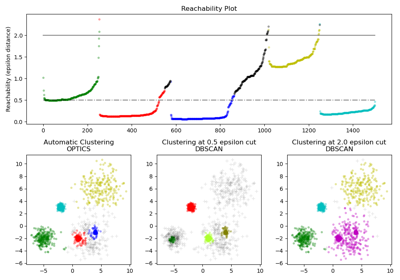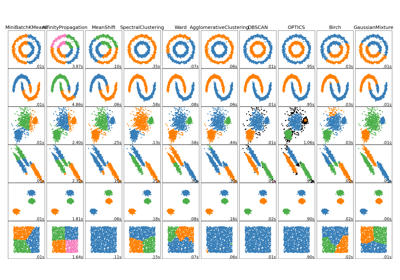sklearn.cluster.OPTICS¶
-
class
sklearn.cluster.OPTICS(*, min_samples=5, max_eps=inf, metric='minkowski', p=2, metric_params=None, cluster_method='xi', eps=None, xi=0.05, predecessor_correction=True, min_cluster_size=None, algorithm='auto', leaf_size=30, n_jobs=None)[source]¶ Estimate clustering structure from vector array.
OPTICS (Ordering Points To Identify the Clustering Structure), closely related to DBSCAN, finds core sample of high density and expands clusters from them [1]. Unlike DBSCAN, keeps cluster hierarchy for a variable neighborhood radius. Better suited for usage on large datasets than the current sklearn implementation of DBSCAN.
Clusters are then extracted using a DBSCAN-like method (cluster_method = ‘dbscan’) or an automatic technique proposed in [1] (cluster_method = ‘xi’).
This implementation deviates from the original OPTICS by first performing k-nearest-neighborhood searches on all points to identify core sizes, then computing only the distances to unprocessed points when constructing the cluster order. Note that we do not employ a heap to manage the expansion candidates, so the time complexity will be O(n^2).
Read more in the User Guide.
- Parameters
- min_samplesint > 1 or float between 0 and 1 (default=5)
The number of samples in a neighborhood for a point to be considered as a core point. Also, up and down steep regions can’t have more then
min_samplesconsecutive non-steep points. Expressed as an absolute number or a fraction of the number of samples (rounded to be at least 2).- max_epsfloat, optional (default=np.inf)
The maximum distance between two samples for one to be considered as in the neighborhood of the other. Default value of
np.infwill identify clusters across all scales; reducingmax_epswill result in shorter run times.- metricstr or callable, optional (default=’minkowski’)
Metric to use for distance computation. Any metric from scikit-learn or scipy.spatial.distance can be used.
If metric is a callable function, it is called on each pair of instances (rows) and the resulting value recorded. The callable should take two arrays as input and return one value indicating the distance between them. This works for Scipy’s metrics, but is less efficient than passing the metric name as a string. If metric is “precomputed”, X is assumed to be a distance matrix and must be square.
Valid values for metric are:
from scikit-learn: [‘cityblock’, ‘cosine’, ‘euclidean’, ‘l1’, ‘l2’, ‘manhattan’]
from scipy.spatial.distance: [‘braycurtis’, ‘canberra’, ‘chebyshev’, ‘correlation’, ‘dice’, ‘hamming’, ‘jaccard’, ‘kulsinski’, ‘mahalanobis’, ‘minkowski’, ‘rogerstanimoto’, ‘russellrao’, ‘seuclidean’, ‘sokalmichener’, ‘sokalsneath’, ‘sqeuclidean’, ‘yule’]
See the documentation for scipy.spatial.distance for details on these metrics.
- pint, optional (default=2)
Parameter for the Minkowski metric from
sklearn.metrics.pairwise_distances. When p = 1, this is equivalent to using manhattan_distance (l1), and euclidean_distance (l2) for p = 2. For arbitrary p, minkowski_distance (l_p) is used.- metric_paramsdict, optional (default=None)
Additional keyword arguments for the metric function.
- cluster_methodstr, optional (default=’xi’)
The extraction method used to extract clusters using the calculated reachability and ordering. Possible values are “xi” and “dbscan”.
- epsfloat, optional (default=None)
The maximum distance between two samples for one to be considered as in the neighborhood of the other. By default it assumes the same value as
max_eps. Used only whencluster_method='dbscan'.- xifloat, between 0 and 1, optional (default=0.05)
Determines the minimum steepness on the reachability plot that constitutes a cluster boundary. For example, an upwards point in the reachability plot is defined by the ratio from one point to its successor being at most 1-xi. Used only when
cluster_method='xi'.- predecessor_correctionbool, optional (default=True)
Correct clusters according to the predecessors calculated by OPTICS [2]. This parameter has minimal effect on most datasets. Used only when
cluster_method='xi'.- min_cluster_sizeint > 1 or float between 0 and 1 (default=None)
Minimum number of samples in an OPTICS cluster, expressed as an absolute number or a fraction of the number of samples (rounded to be at least 2). If
None, the value ofmin_samplesis used instead. Used only whencluster_method='xi'.- algorithm{‘auto’, ‘ball_tree’, ‘kd_tree’, ‘brute’}, optional
Algorithm used to compute the nearest neighbors:
‘ball_tree’ will use
BallTree‘kd_tree’ will use
KDTree‘brute’ will use a brute-force search.
‘auto’ will attempt to decide the most appropriate algorithm based on the values passed to
fitmethod. (default)
Note: fitting on sparse input will override the setting of this parameter, using brute force.
- leaf_sizeint, optional (default=30)
Leaf size passed to
BallTreeorKDTree. This can affect the speed of the construction and query, as well as the memory required to store the tree. The optimal value depends on the nature of the problem.- n_jobsint or None, optional (default=None)
The number of parallel jobs to run for neighbors search.
Nonemeans 1 unless in ajoblib.parallel_backendcontext.-1means using all processors. See Glossary for more details.
- Attributes
- labels_array, shape (n_samples,)
Cluster labels for each point in the dataset given to fit(). Noisy samples and points which are not included in a leaf cluster of
cluster_hierarchy_are labeled as -1.- reachability_array, shape (n_samples,)
Reachability distances per sample, indexed by object order. Use
clust.reachability_[clust.ordering_]to access in cluster order.- ordering_array, shape (n_samples,)
The cluster ordered list of sample indices.
- core_distances_array, shape (n_samples,)
Distance at which each sample becomes a core point, indexed by object order. Points which will never be core have a distance of inf. Use
clust.core_distances_[clust.ordering_]to access in cluster order.- predecessor_array, shape (n_samples,)
Point that a sample was reached from, indexed by object order. Seed points have a predecessor of -1.
- cluster_hierarchy_array, shape (n_clusters, 2)
The list of clusters in the form of
[start, end]in each row, with all indices inclusive. The clusters are ordered according to(end, -start)(ascending) so that larger clusters encompassing smaller clusters come after those smaller ones. Sincelabels_does not reflect the hierarchy, usuallylen(cluster_hierarchy_) > np.unique(optics.labels_). Please also note that these indices are of theordering_, i.e.X[ordering_][start:end + 1]form a cluster. Only available whencluster_method='xi'.
See also
DBSCANA similar clustering for a specified neighborhood radius (eps). Our implementation is optimized for runtime.
References
- 1(1,2)
Ankerst, Mihael, Markus M. Breunig, Hans-Peter Kriegel, and Jörg Sander. “OPTICS: ordering points to identify the clustering structure.” ACM SIGMOD Record 28, no. 2 (1999): 49-60.
- 2
Schubert, Erich, Michael Gertz. “Improving the Cluster Structure Extracted from OPTICS Plots.” Proc. of the Conference “Lernen, Wissen, Daten, Analysen” (LWDA) (2018): 318-329.
Examples
>>> from sklearn.cluster import OPTICS >>> import numpy as np >>> X = np.array([[1, 2], [2, 5], [3, 6], ... [8, 7], [8, 8], [7, 3]]) >>> clustering = OPTICS(min_samples=2).fit(X) >>> clustering.labels_ array([0, 0, 0, 1, 1, 1])
Methods
fit(X[, y])Perform OPTICS clustering.
fit_predict(X[, y])Perform clustering on X and returns cluster labels.
get_params([deep])Get parameters for this estimator.
set_params(**params)Set the parameters of this estimator.
-
__init__(*, min_samples=5, max_eps=inf, metric='minkowski', p=2, metric_params=None, cluster_method='xi', eps=None, xi=0.05, predecessor_correction=True, min_cluster_size=None, algorithm='auto', leaf_size=30, n_jobs=None)[source]¶ Initialize self. See help(type(self)) for accurate signature.
-
fit(X, y=None)[source]¶ Perform OPTICS clustering.
Extracts an ordered list of points and reachability distances, and performs initial clustering using
max_epsdistance specified at OPTICS object instantiation.- Parameters
- Xarray, shape (n_samples, n_features), or (n_samples, n_samples) if metric=’precomputed’
A feature array, or array of distances between samples if metric=’precomputed’.
- yignored
Ignored.
- Returns
- selfinstance of OPTICS
The instance.
-
fit_predict(X, y=None)[source]¶ Perform clustering on X and returns cluster labels.
- Parameters
- Xarray-like of shape (n_samples, n_features)
Input data.
- yIgnored
Not used, present for API consistency by convention.
- Returns
- labelsndarray of shape (n_samples,)
Cluster labels.
-
get_params(deep=True)[source]¶ Get parameters for this estimator.
- Parameters
- deepbool, default=True
If True, will return the parameters for this estimator and contained subobjects that are estimators.
- Returns
- paramsmapping of string to any
Parameter names mapped to their values.
-
set_params(**params)[source]¶ Set the parameters of this estimator.
The method works on simple estimators as well as on nested objects (such as pipelines). The latter have parameters of the form
<component>__<parameter>so that it’s possible to update each component of a nested object.- Parameters
- **paramsdict
Estimator parameters.
- Returns
- selfobject
Estimator instance.


